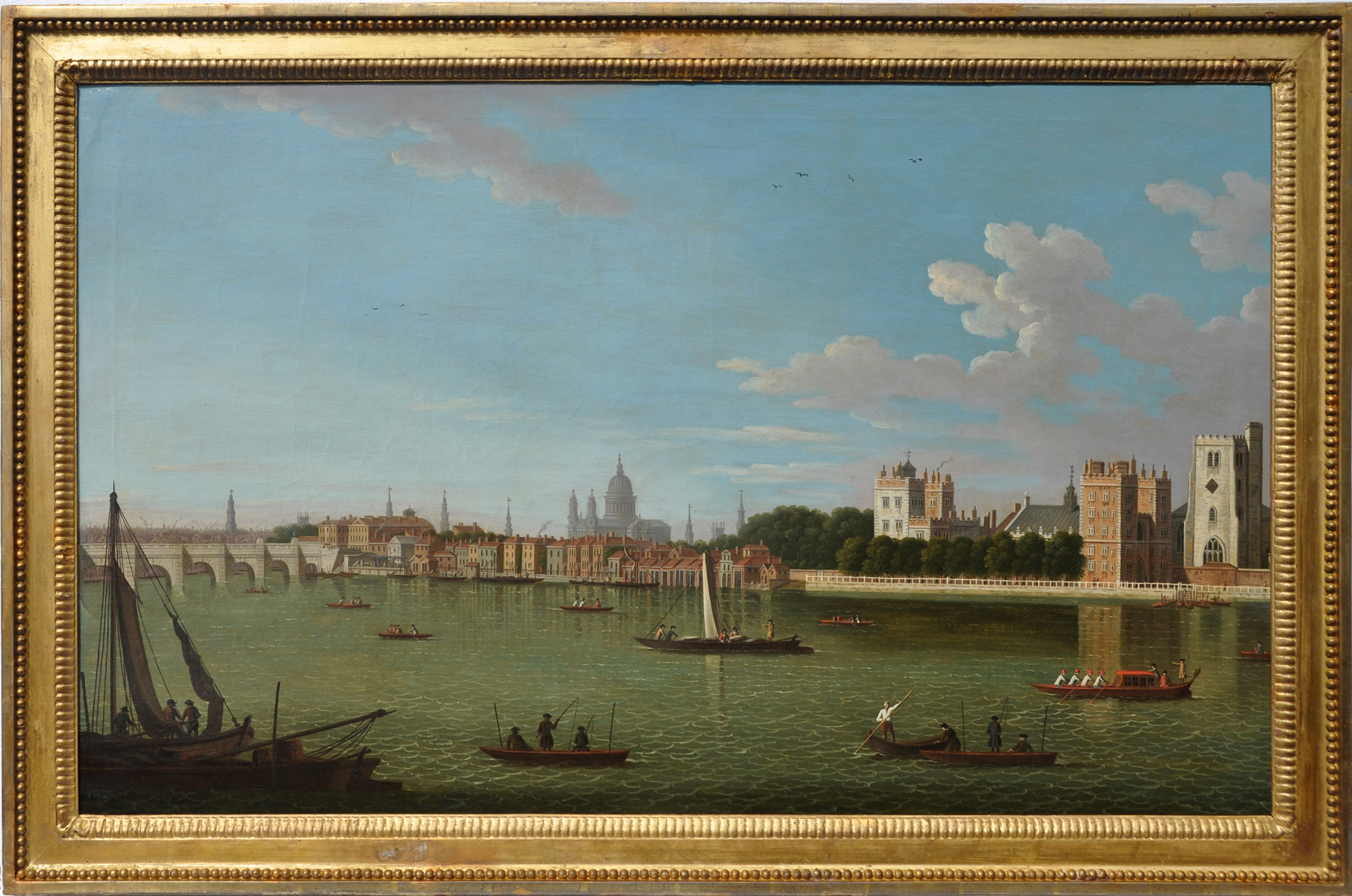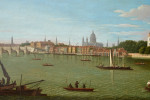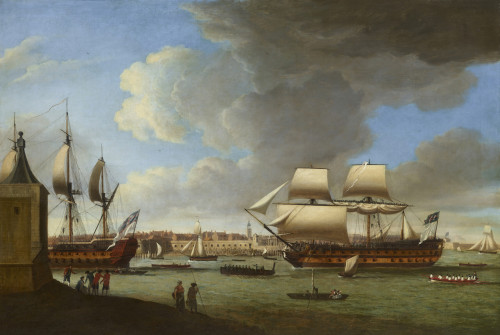A view of the Thames from the north bank with Old Westminster Bridge, Lambeth Palace and St Paul’s
A view of the Thames from the north bank with Old Westminster Bridge, Lambeth Palace and St Paul’s
JOSEPH NICHOLLS
Fl. 1726 - 1755
English School
A view of the Thames from the north bank with Old Westminster Bridge,
Lambeth Palace and St Paul’s
Oil on canvas
61 x 102 cms
24 x 401//8 inches
Overall framed size 71.3 x 112.5 cms
281/8 x 441/4 ins
Britain is fortunate in that it has an unrivalled record of topographical records compared to Europe. On the continent, major towns or cities were occasionally depicted as were important castles or palaces such as Versailles for example, but in Britain there is an abundance of engravings and paintings depicting country houses, churches, villages, towns, cities and parts of them.
The astonishing wealth of records, “There is simply nothing like this in the rest of Europe, not even after 1800, and no other country in the world has today such an efficient system of rate-supported County Record or Archive Offices which take into their care the paper history of the county” (John Harris in ‘Prospects of Town and Park’ – National Art-Collections Fund Exhibition, Colnaghi 1988) There were large numbers of antiquarians and there was enormous interest in recording the history and topographical views in written and painted records. One can only surmise why this is the case; perhaps it is a deep-rooted consequence of the Domesday Book, but whatever the reason, there is an abundance of painted views and aspects of houses and urban areas.
Therefore it is rather ironic that the genre of topographical painting had really been introduced to England from Northern Europe where artists in the Netherlands had an established tradition. There are few surviving illustrations from the Tudor period although some artists from the Low Countries such as Hoefnagel in 1568 and van der Wyngaerde in 1559 did work in England. It was following the Restoration and the coronation of Charles II in 1660, marking the end of the governance of Parliament, and then, particularly after the accession of William of Orange in 1689, that the influence of art and architecture from Holland became marked in England.
The Earl of Arundel had returned from a mission to Vienna in 1636 with the Prague born artist Wenceslaus Hollar who remained here until 1644. He returned again in 1652, remaining until his death in 1677 and although most of his work survives in engraved form, he was a significant influence on English landscape painting. He managed to impart an English sensibility to the Northern European style and this can be discerned in “A View of the Thames below Wesminster Pier” now in the Barber Institute.
By the late part of the 17th century and into the 18th, artists such as Jacob Knyff, Jan Griffier, Thomas Wyck, Hendrik Danckerts and Johannes Vorsterman followed a little later by Pieter Tillemans, Jan Siberechts, Leonard Knyff and Pieter Andreas Rysbrack the Younger were in residence here and were being commissioned to paint panoramic views of country houses and estates as well as towns and views of London from the Thames. Printed guides started to appear in the early 1700s with engravings county by county and the number of architectural books published in Britain between 1715 and 1800 exceeded that of the whole of Europe in the same period. There was a seemingly almost insatiable desire to have a record of man’s achievements in developing the built environment and bringing order to nature.
Joseph Nicholls, sometimes recorded as Nichols or Nickols, was one of the best of the English comparatively obscure painters of eighteenth century London views. In the 1740s topographical art in Britain received an invigorating influence from Italy, a consequence of the increasing popularity of the Grand Tour. The most famous of the Italian artists were Canaletto and Antonio Joli and the former’s paintings had started to reach these shores in the late 1720s. Canaletto himself arrived in London in the summer of 1746. George Vertue, in his Notebooks in the Walpole Society writes: “…came to London from Venice the Famous Painter of Views Cannalletti …the Multitude of his works done abroad for English noblemen and Gentlemen has procurd him great reputation and his great merit and excellence in that way, he is much esteemed…” His “Whitehall and the Privy Garden from Richmond House” and “The Thames and the City of London from Richmond House”, both magnificent paintings and now at Goodwood, had a marked effect.
Canaletto’s paintings of “A View of Westminster from the Terrace of Somerset House” and “The Thames from Somerset House Terrace towards the City” were both engraved in 1751 and there can be no doubt that these engravings acted as a further stimulus to contemporary and later artists to depict similar compositions.
The English painters Samuel Scott, William James and William Marlow picked up on this style and there were several others of varying ability such as Samuel Wale, Francis Hardin, Thomas Priest and Herbert Pugh who were commissioned to paint views of a city rapidly expanding in size, influence and wealth. There is evidence though that Scott was already painting topographical views of London before the arrival of Canaletto with a drawing of Westminster Abbey and Hall from the River in the British Museum confidently dated to 1738 providing the evidence for this. There is also speculation that some of these painters utilised a camera lucida or other such optical devices which would explain some of the occasional distorted buildings, even apparent in an artist of Scott’s ability.
Joseph Nicholls preceded these more illustrious first three named artists and his pictures show a good topographical ability and feeling of atmosphere for the Thames. Grant writes of him that “…there is a delicacy and finesse in his work, unusual in this type…he displayed a capacity also for foliage and scenery.”
There is comparatively little known about Nicholls. He was from Bengeo in Hertfordshire, the son of a husbandman, and is believed to have been apprenticed to the Painter-Stainer Thomas Batten on 5th August 1713. He was certainly painting London views by 1738 as two of his paintings - “Stocks Market” and “Fountain in the Temple” – were engraved in that year. Examples of his painting are in the collections of the University of Greenwich, the City of London Corporation, Gunnersbury Park Museum, National Trust (Nostell Priory) and there are a pair of views of Twickenham in the Mellon Collection at Yale, one showing Pope’s Villa and the other Orlean’s House, one of which is dated 1726, but which was probably painted after 1755. Another painting, “View of the Thames”, is dated 1748 but these signed and dated works are scarce. Other examples of his work include “The Thames at Lambeth Palace” and “Charing Cross with the Statue of King Charles I and Northumberland House”.
Nicholls also worked as an illustrator and these engravings can be seen in Captain Johnson’s “Famous Highwaymen, Murderers, etc” published in 1734. There is also an oil painting depicting a capriccio Italian scene which has his signature on it which was probably a commission work in England done from another painting(s) or engraving(s).
Bibliography:
Dictionary of British Landscape Painters - M H Grant
Dictionary of British 18th Century Painters - Ellis Waterhouse
British Landscape Painters of the 18th Century – Luke Hermann
Prospects of Town and Park – National Art Collections Fund Exhibition, Colnaghi 1988
Book Illustration in 18th Century England - Hanns Hammelmann
Old and New London Vol. V – Edward Walford
RELATED ITEMS























